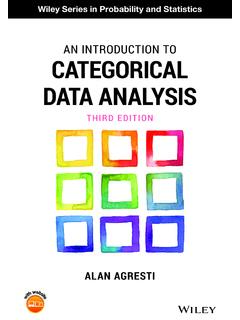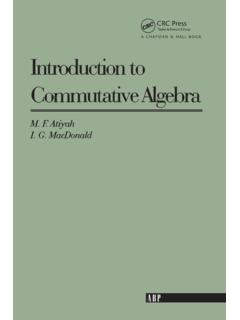Transcription of An Introduction to Categorical Data Analysis
1 Wiley Series in Probability and Statistics AN Introduction TO. Categorical . DATA Analysis . THIRD EDITION. ALAN AGRESTI. AN Introduction TO. Categorical DATA Analysis . WILEY SERIES IN PROBABILITY AND STATISTICS. Established by Walter A. Shewhart and Samuel S. Wilks Editors: David J. Balding, Noel A. C. Cressie, Garrett M. Fitzmaurice, Geof H. Givens, Harvey Goldstein, Geert Molenberghs, David W. Scott, Adrian F. M. Smith, Ruey S. Tsay Editors Emeriti: J. Stuart Hunter, Iain M. Johnstone, Joseph B. Kadane, Jozef L. Teugels The Wiley Series in Probability and Statistics is well established and authoritative. It covers many topics of current research interest in both pure and applied statistics and probability theory. Written by leading statisticians and institutions, the titles span both state-of-the-art developments in the eld and classical methods.
2 Re ecting the wide range of current research in statistics, the series encompasses applied, methodological and theoretical statistics, ranging from applications and new techniques made possible by advances in computerized practice to rigorous treatment of theoretical approaches. This series provides essential and invaluable reading for all statisticians, whether in academia, industry, government, or research. A complete list of titles in this series can be found at AN Introduction TO. Categorical DATA. Analysis . Third Edition Alan Agresti University of Florida, Florida, United States This third edition rst published 2019. 2019 John Wiley & Sons, Inc. Edition History (1e, 1996); John Wiley & Sons, Inc. (2e, 2007); John Wiley & Sons, Inc. All rights reserved. No part of this publication may be reproduced, stored in a retrieval system, or transmitted, in any form or by any means, electronic, mechanical, photocopying, recording or otherwise, except as permitted by law.
3 Advice on how to obtain permission to reuse material from this title is available at The right of Alan Agresti to be identi ed as the author of this work has been asserted in accordance with law. Registered O ce John Wiley & Sons, Inc., 111 River Street, Hoboken, NJ 07030, USA. Editorial O ce 111 River Street, Hoboken, NJ 07030, USA. For details of our global editorial o ces, customer services, and more information about Wiley products visit us at Wiley also publishes its books in a variety of electronic formats and by print-on-demand. Some content that appears in standard print versions of this book may not be available in other formats. Limit of Liability/Disclaimer of Warranty While the publisher and authors have used their best e orts in preparing this work, they make no representations or warranties with respect to the accuracy or completeness of the contents of this work and speci cally disclaim all warranties, including without limitation any implied warranties of merchantability or tness for a particular purpose.
4 No warranty may be created or extended by sales representatives, written sales materials or promotional statements for this work. The fact that an organization, website, or product is referred to in this work as a citation and/or potential source of further information does not mean that the publisher and authors endorse the information or services the organization, website, or product may provide or recommendations it may make. This work is sold with the understanding that the publisher is not engaged in rendering professional services. The advice and strategies contained herein may not be suitable for your situation. You should consult with a specialist where appropriate. Further, readers should be aware that websites listed in this work may have changed or disappeared between when this work was written and when it is read.
5 Neither the publisher nor authors shall be liable for any loss of pro t or any other commercial damages, including but not limited to special, incidental, consequential, or other damages. Library of Congress Cataloging-in-Publication Data Names: Agresti, Alan, author. Title: An Introduction to Categorical data Analysis / Alan Agresti. Description: Third edition. | Hoboken, NJ : John Wiley & Sons, 2019. | Series: Wiley series in probability and statistics | Includes bibliographical references and index. |. Identi ers: LCCN 2018026887 (print) | LCCN 2018036674 (ebook) | ISBN 9781119405276 (Adobe PDF) |. ISBN 9781119405283 (ePub) | ISBN 9781119405269 (hardcover). Subjects: LCSH: Multivariate Analysis . Classi cation: LCC QA278 (ebook) | LCC QA278 .A355 2019 (print) | DDC dc23. LC record available at Cover Design: Wiley Cover Image: Set in 10 Nimbus by Aptara Inc.
6 , New Delhi, India Printed in the United States of America 10 9 8 7 6 5 4 3 2 1. CONTENTS. Preface ix About the Companion Website xiii 1 Introduction 1. Categorical Response Data 1. Probability Distributions for Categorical Data 3. Statistical Inference for a Proportion 5. Statistical Inference for Discrete Data 10. Bayesian Inference for Proportions * 13. Using R Software for Statistical Inference about Proportions * 17. Exercises 21. 2 Analyzing Contingency Tables 25. Probability Structure for Contingency Tables 26. Comparing Proportions in 2 2 Contingency Tables 29. The Odds Ratio 31. Chi-Squared Tests of Independence 36. Testing Independence for Ordinal Variables 42. Exact Frequentist and Bayesian Inference * 46. Association in Three-Way Tables 52. Exercises 56. v vi CONTENTS. 3 Generalized Linear Models 65.
7 Components of a Generalized Linear Model 66. Generalized Linear Models for Binary Data 68. Generalized Linear Models for Counts and Rates 72. Statistical Inference and Model Checking 76. Fitting Generalized Linear Models 82. Exercises 84. 4 Logistic Regression 89. The Logistic Regression Model 89. Statistical Inference for Logistic Regression 94. Logistic Regression with Categorical Predictors 98. Multiple Logistic Regression 102. Summarizing E ects in Logistic Regression 107. Summarizing Predictive Power: Classi cation Tables, ROC Curves, and Multiple Correlation 110. Exercises 113. 5 Building and Applying Logistic Regression Models 123. Strategies in Model Selection 123. Model Checking 130. In nite Estimates in Logistic Regression 136. Bayesian Inference, Penalized Likelihood, and Conditional Likelihood for Logistic Regression * 140.
8 Alternative Link Functions: Linear Probability and Probit Models * 145. Sample Size and Power for Logistic Regression * 150. Exercises 151. 6 Multicategory Logit Models 159. Baseline-Category Logit Models for Nominal Responses 159. Cumulative Logit Models for Ordinal Responses 167. Cumulative Link Models: Model Checking and Extensions * 176. Paired-Category Logit Modeling of Ordinal Responses * 184. Exercises 187. 7 Loglinear Models for Contingency Tables and Counts 193. Loglinear Models for Counts in Contingency Tables 194. Statistical Inference for Loglinear Models 200. The Loglinear Logistic Model Connection 207. CONTENTS vii Independence Graphs and Collapsibility 210. Modeling Ordinal Associations in Contingency Tables 214. Loglinear Modeling of Count Response Variables * 217. Exercises 221. 8 Models for Matched Pairs 227.
9 Comparing Dependent Proportions for Binary Matched Pairs 228. Marginal Models and Subject-Speci c Models for Matched Pairs 230. Comparing Proportions for Nominal Matched-Pairs Responses 235. Comparing Proportions for Ordinal Matched-Pairs Responses 239. Analyzing Rater Agreement * 243. Bradley Terry Model for Paired Preferences * 247. Exercises 249. 9 Marginal Modeling of Correlated, Clustered Responses 253. Marginal Models versus Subject-Speci c Models 254. Marginal Modeling: The Generalized Estimating Equations (GEE). Approach 255. Marginal Modeling for Clustered Multinomial Responses 260. Transitional Modeling, Given the Past 263. Dealing with Missing Data * 266. Exercises 268. 10 Random Effects: Generalized Linear Mixed Models 273. Random E ects Modeling of Clustered Categorical Data 273. Examples: Random E ects Models for Binary Data 278.
10 Extensions to Multinomial Responses and Multiple Random E ect Terms 284. Multilevel (Hierarchical) Models 288. Latent Class Models * 291. Exercises 295. 11 Classification and Smoothing * 299. Classi cation: Linear Discriminant Analysis 300. Classi cation: Tree-Based Prediction 302. Cluster Analysis for Categorical Responses 306. Smoothing: Generalized Additive Models 310. Regularization for High-Dimensional Categorical Data (Large p) 313. Exercises 321. viii CONTENTS. 12 A Historical Tour of Categorical Data Analysis * 325. Appendix: Software for Categorical Data Analysis 331. R for Categorical Data Analysis 331. SAS for Categorical Data Analysis 332. Stata for Categorical Data Analysis 342. SPSS for Categorical Data Analysis 346. Brief Solutions to Odd-Numbered Exercises 349. Bibliography 363. Examples Index 365.










